Exploring Ozone Kitesurfing Innovations and Techniques


Intro
Kitesurfing is more than just a sport; it is a blend of adventure, skill, and connection with nature. When it comes to kitesurfing, Ozone stands out as a prominent brand, respected for its commitment to quality and innovation. In this article, we will take a closer look at what makes Ozone kites unique and how they enhance the kitesurfing experience.
By examining the various kite models Ozone offers and the advanced technologies behind them, we’ll address how these impact performance across a range of conditions. We will also touch on the essential gear and safety measures every kitesurfer should know, whether you’re just getting your feet wet or are honing your skills for more advanced maneuvers.
Kitesurfing isn’t just about thrilling moments on the water; it carries cultural significance and environmental responsibilities. Understanding how weather conditions affect performance and the sustainable practices associated with the sport is crucial. So let’s delve into this exhilarating activity, highlighting the underlying factors that make Ozone kitesurfing a thrilling yet conscientious pursuit.
Intro to Kitesurfing
Kitesurfing has gained significant traction over the past few decades, turning from a niche activity into a globally recognized sport. This growth is not just a passing fad; it highlights the evolution and accessibility of the sport, making it an engaging pursuit for adventurers and thrill-seekers alike. Understanding kitesurfing sets the stage for diving deeper into the specifics of Ozone kites, which are pivotal in enhancing the overall experience on the water. Through a careful examination of kitesurfing, we can appreciate not only its physical challenges and rewards but also the camaraderie it fosters among practitioners.
Defining Kitesurfing
Kitesurfing, at its core, marries the elements of surfing and flying a kite. It involves riding on a board while being propelled by a large, controllable kite. The synergy between wind, water, and the rider creates a dynamic gameplay that is as much about skill as it is about understanding the environment. Essentially, kitesurfing provides freedom on the water, combining adrenaline with the tranquil beauty of nature. When you’re out there, harnessing the wind’s energy, it feels like you're dancing with the forces of nature. With the right gear, like the Ozone kites, this dance becomes even more exhilarating.
Evolution of Kitesurfing Gear
Kitesurfing gear has come a long way since its early days. What began as a crude assemblage of materials has transformed into high-tech equipment designed for safety and performance. The first kites were typically home-made, using surfboards or skis tied to oversized kites. Today, companies like Ozone have revolutionized kitesurfing gear through innovation and engineering.
- Kites: Modern kites are made with lightweight, durable materials and come in various types tailored for different conditions. The evolution into different kite designs, such as inflatables and foils, provides unparalleled options for riders.
- Boards: Originally simple and limited, kitesurfing boards now have diverse designs, offering features that cater to different styles such as freeriding, waves, and racing.
- Safety gear: As the sport evolved, so did the focus on safety. Modern harnesses, control bars, and safety systems are designed to ensure that riders can enjoy kitesurfing while mitigating risks.
Understanding this evolution is vital not only for selecting the right gear but also for appreciating the craftsmanship behind Ozone’s innovations. Each kite or board reflects decades of progress and expertise, making kitesurfing both a sport and an art form.
"Kitesurfing blends the thrill of speed, the joy of playing on water, and the serenity of nature—a unique experience unlike any other."
Through this lens of exploration, we can see how kitesurfing and its gear, especially Ozone kites, create a platform for adventure. Mastering the sport is not merely about technical skills; it involves understanding the interplay between a rider, their equipment, and the environment. This foundational understanding is essential as we further explore Ozone kites and their contributions to the sport.
Overview of Ozone Kites
Ozone kites have carved out a significant niche in the kitesurfing world, setting benchmarks that both enthusiasts and professionals alike respect. Understanding Ozone kites is more than just an appreciation of their design; it delves into the ethos behind the brand, their commitment to innovation, and the impact their kites have on a rider’s performance. The brand's prominence in the industry is not just a matter of marketing; it’s tied to the quality and advanced technology offered in their products.
The journey of Ozone began in the late 1990s, originating from a passion for power kiting. Over time, this passion blossomed into a well-respected brand that serves a wide range of riders. With every product line, Ozone not only emphasizes performance but also seeks to make kitesurfing accessible to beginners while catering to those who chase the adrenaline rush of advanced maneuvers.
Importance of Ozone Kites
Ozone kites are engineered to withstand diverse conditions, making them suitable for various environments, from flat waters to challenging waves. This adaptability is a major consideration for kitesurfers who often encounter a spectrum of weather patterns on their adventures. They prioritize durability, aerodynamics, and usability in their designs, offering riders home in extreme situations.
A noteworthy characteristic of Ozone kites is their attention to safety. The development of reliable safety features reflects the brand's commitment to minimizing the risks inherent in kitesurfing. Thus, kites equipped with efficient depower systems allow for quick reactions during unforeseen circumstances, making them more than just tools; they become safety nets for the adventurous spirit.
As we flip through the pages of Ozone's legacy, it is essential to highlight that the company stands out not only for its products but also for fostering a vibrant community of riders. This aspect amplifies the kites’ significance in the culture of kitesurfing, as Ozone has a keen focus on collaboration and sharing knowledge among enthusiasts.
Key Takeaways
- Ozone’s commitment to innovation sets them apart in the kitesurfing industry.
- The versatility of their kites accommodates a broad range of skill levels and wind conditions.
- Safety features integrated into the design enhance rider confidence and performance.
- Ozone fosters community engagement, contributing to the overall growth and enthusiasm surrounding kitesurfing.
In summary, the overview of Ozone kites illustrates their undeniable influence in the realm of kitesurfing. The focus on innovation, safety, and community engagement makes Ozone a brand worth exploring in detail.
Types of Ozone Kites
When diving into the realm of kitesurfing, understanding the different types of Ozone kites is essential. Each kite is designed with a unique purpose and performance style in mind, catering to various skill levels and preferences. Selecting the right kite is akin to choosing the appropriate tool for a job; the right match can vastly enhance your experience on the water. In this section, we’ll explore the various kite types offered by Ozone, breaking them down into their specific functionalities, benefits, and considerations.
Freeride Kites
Freeride kites stand out for their versatility and ease of use. Designed for a broad range of conditions, they suit both beginners and more seasoned riders looking for a flexible kite that can handle various wind strengths with grace.
- Features: Freeride kites typically have a pully bridled design which allows for better lift and easier relaunch. They often offer stability, good speed, and sufficient power to make jumps without excessive effort.
- Benefits: Ideal for days when the winds are unpredictable, these kites are forgiving. If you’re just starting out, a freeride kite can help you build confidence without overwhelming you with performance demands.
- Considerations: Although they are adaptable, freeride kites may not perform as well in specialized conditions like big waves or high-performance racing scenarios. This limits their use if you're aiming for advanced tricks or dynamic riding.
Wave Kites
Wave kites are tailored for those who crave the rush of surfing the ocean's swells. They maintain a balance between power and maneuverability, making them ideal for kitesurfers who desire to ride waves with control and finesse.
- Features: These kites are typically smaller and have a higher aspect ratio. This enables quicker turns while enhancing stability in gusty conditions.
- Benefits: Wave kites excel in providing the precise control needed to navigate turbulent water. Their design allows riders to focus on surfing rather than battling against their equipment.
- Considerations: If you mostly ride flat water or seek high-speed performance, wave kites might not be the best choice. They shine best in ocean waves where their agility and control come to life.
Foil Kites
Foil kites are somewhat of a niche option but have gained traction among enthusiasts seeking efficiency and lightweight options. They differ significantly from traditional inflatable kites, showcasing a design that inflates with air through its cells.
- Features: Foil kites are generally lighter and pack down smaller, making them an excellent choice for travel. They offer steady performance, especially in lighter winds.
- Benefits: With their high lift-to-drag ratio, they excel at gliding effortlessly over water, providing a unique experience. This can be particularly engaging when conditions are less than ideal.
- Considerations: The learning curve can be steeper with foil kites for beginners, as they require a more refined understanding of kite control. Additionally, they may not perform optimally in high wind conditions.
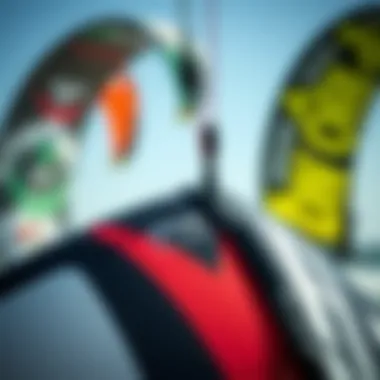

Hybrid Kites
Hybrid kites combine characteristics from different kite types to offer a well-rounded riding experience. They serve as a bridge, offering versatility and flexibility, appealing particularly to those who like to dabble in various kitesurfing activities.
- Features: Bringing together the best of directional, freeride, and even wave kites, hybrids often possess a unique design that supports multiple styles of riding.
- Benefits: Ideal for the adventurous kitesurfer who doesn't want to be pinned down to a single discipline, hybrid kites can smoothly transition between waves, flat water, and freestyle.
- Considerations: While hybrid kites strive for adaptability, some riders may find that they don’t excel in specific conditions compared to dedicated kite types. Consider where you will be riding most often before making a decision.
"Choosing the right kite can drastically alter your kitesurfing experience; it all comes down to understanding your preferences and riding conditions."
Choosing the Right Ozone Kite
Selecting the appropriate Ozone kite is a key determinant of your overall kitesurfing experience. With an everso diverse range of kite styles, sizes, and designs from Ozone, making an informed choice can significantly enhance performance and safety in various conditions. Understanding your needs and the specifics of kitesurfing equipment is fundamental for both newcomers and advanced riders. A kite that complements your skill level and riding ambitions sets the stage for enjoyment, progression, and even competitive success.
Assessing Your Skill Level
Your proficiency on the water has a domino effect in the decision of the right kite. If you are just starting out, it's wise to consider a more stable and predictable kite. In this realm, Ozone's Freeride kites often serve as a gentle introduction. Their ease of control allows beginners to grasp the essentials without feeling overwhelmed.
On the flip side, seasoned riders might be drawn to Wave or Foil kites, as these designs enable more advanced maneuvers and adaptations to varying wind conditions. Notably, understanding your personal growth trajectory is invaluable; it’s wise not to overshoot your current skills in an attempt to get equipment that might seem trendy or appealing.
Understanding Wind Conditions
Wind can transform a good session into a great one, or vice versa. Grasping how different wind patterns affect kitesurfing is essential. Ozone kites come equipped with innovative designs that perform uniquely in various wind settings. Having a kite suited to the typical wind variations in your locale ensures you won’t be left high and dry—or caught in a gale.
A common consideration is that lighter kites excel in low wind, whereas heavy-duty models might hold their own during high winds. Furthermore, it's worth checking coastal conditions, tide interactions, and local weather forecasts to pinpoint the most favorable conditions for your session. Always remember, knowing when to ride is just as vital as having the right kite.
Sizing Your Kite
Selecting the right size kite hinges on a delicate balance between your weight, skill level, and the wind conditions you'll encounter. Each kite has specifics on size that indicate optimal usage; generally, larger kites catch more wind but can be harder to control, especially for inexperienced riders.
An easy rule of thumb: for lighter winds, aim for a larger kite while a smaller model works better in strong winds. It’s advised to consult Ozone’s size chart online and perhaps reach out to local instructors or experienced kite surfers at your spot to ensure you're hitting the right notes with your choice.
"Choosing poorly can not only lead to frustration but also pose risks. A well-suited kite can significantly elevate your enjoyment and skill advancement."
Essential Gear for Ozone Kitesurfing
When it comes to kitesurfing, having the right gear is just as vital as mastering the skills to fly across the water. Ozone kitesurfing involves a unique set of equipment tailored to enhance performance and safety on the waves. Understanding the essential gear can significantly impact your experience, whether you’re a weekend warrior or a seasoned pro.
Kiteboards: Types and Selection
When choosing a kiteboard, it’s crucial to consider what type of riding you plan to do—be it freeride, freestyle, or wave riding. Kiteboards come in various shapes, sizes and materials.
- Twin-Tip Boards: Perfect for general riding and tricks, these boards allow you to ride both directions easily.
- Directional Boards: Ideal for wave riding, directional boards are designed to go one way, much like a surfboard. They require a bit of time to get used to but can be very rewarding.
- Foil Boards: If you want to glide gracefully over the water, a foil board lifts above the surface—ideal for light wind conditions.
Pay attention to the board's size, as it should correspond with your weight and the wind conditions. A larger board can provide more stability and comfort for beginners, whereas lighter, smaller boards are often favored by advanced riders looking to perform tricks.
Harnesses: Function and Fit
Harnesses serve a primary purpose—they distribute the power of the kite across your body. This allows you to ride longer without fatigue. There are two main types of harnesses: waist and seat harnesses.
- Waist Harnesses: These are popular among riders because they offer a more progressive and less restrictive feel. They give a good range of motion, making it easier to perform tricks.
- Seat Harnesses: These sit lower on the hips, offering more support for heavier pulls. They are often chosen by beginners as they provide a sense of security and reduce the chances of getting yanked out of position.
Finding the right fit is key. The harness should be snug but not constricting; your body should feel secure without being squeezed.
Control Bars and Lines
Control bars are your lifeline when kitesurfing. The engagement of the bar directly correlates with your kite’s performance. A good control bar allows for precise handling, which is vital in dynamic wind conditions. Consider the following aspects:
- Width of the Bar: A wider bar offers more leverage, making it easier to control the kite, especially in gusty winds.
- Safety Systems: Most bars come with safety features to release the kite in emergencies, and this function should be familiar to every kitesurfer.
- Line Length: Longer lines can give you more elevation and speed, however, they require more control.
Make sure to check that your lines are free of tangles and wear. Damaged lines can lead to disastrous results—never compromise on the condition of your gear.
Safety Equipment Necessities
Kitesurfing is thrilling but not without risks. Safety equipment is not just a good idea; it's a necessity. Here’s a list of must-have safety gear for anyone hitting the water:
- Helmet: Protects your dome from the unexpected impacts of falls or collisions.
- Impact Vest: While it won’t replace a life vest, it can help with buoyancy and protect against hard landings.
- Life Jacket: If you’re riding in deep waters, a life jacket could literally be a lifesaver.
- Leash: This keeps your kite connected to you, minimizing the odds of losing your gear and allowing for quick retrieval.
Remember, when you're out enjoying the waves, your safety gear is your first line of defense against unforeseen mishaps.
To sum it up, understanding the essential gear for Ozone kitesurfing is imperative to both enjoyment and safety. Selecting the right kiteboards, harnesses, control setups, and safety equipment plays a crucial role in shaping your experience on the water, whether you’re just starting or have been surfing for years.
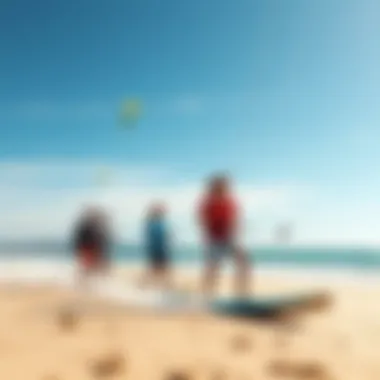
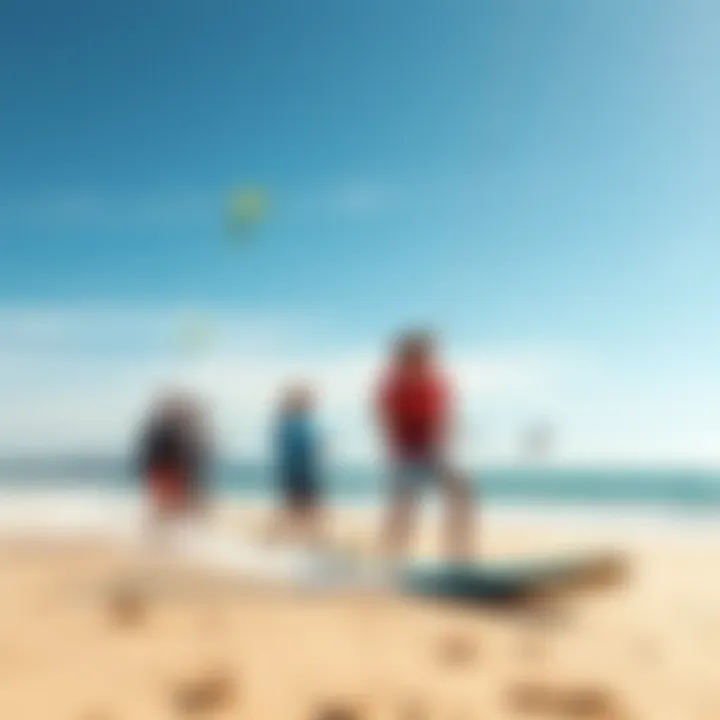
"Investing in quality kitesurfing gear is not just about performance, it's about ensuring your time on the water is as enjoyable and safe as possible."
For more insights about kitesurfing gear and safety, consider exploring resources from Wikipedia or community discussions on Reddit.
Techniques for Kitesurfing
Kitesurfing is an exhilarating sport, but it’s much more than just flying a kite over water. It involves a variety of techniques that can dramatically improve performance and safety. Mastering these techniques is akin to learning the craft of an artist—the more you practice, the better your control and nuances become. In this section, we’ll explore essential kitesurfing techniques, diving into basics, advanced moves, and crucial emergency procedures that every kitesurfer should know.
Basic Riding Techniques
Mastering the fundamentals of riding is where all kitesurfers should begin. Getting the basics right not only makes the sport enjoyable but also prevents mistakes that could lead to accidents.
- Understanding Power Zones
The kite’s power zone is an area in which it exerts the most force. By positioning your kite in the right part of this zone, you can maximize lift and speed. It’s essential to learn how kinesthetics of the kite influence your riding. - Body Positioning
Keeping a balanced stance is key. Your body should remain perpendicular to the direction of travel, and the knees should be slightly bent for shock absorption. Hunching over will only add strain to your muscles. - Edging and Control
Edging allows you to maintain speed and navigate turns. You should lean back and apply pressure to the heel edge of your board as you turn. This technique requires practice to get a good feel for how to balance speed and braking. - Tackling the Water
Knowing how to ride upwind is crucial since it allows you to explore more areas without getting too far from the starting point. Learning the proper angle relative to the wind direction—usually around 45 degrees—will prove beneficial.
As you refine these skills, you'll appreciate how they create a foundation for more advanced techniques.
Advanced Maneuvers and Tricks
Once the basics are under your belt, you may want to learn impressive maneuvers that dazzle onlookers and make your sessions even more fulfilling. Here’s what’s often deemed the next step:
- Jumping
Mastering jumps involves timing your pop with the kite's lift. To jump effectively, you’ll need to edge hard, pull on the back of the bar, and shift your weight upward while simultaneously pulling the kite back. Landing smoothly is all about managing your body position as you come down. - Riding Blind
This trick can really bring your style to the next level. It involves turning your head and body to the rear while keeping upwind with the kite still above you. It takes a lot of guts to trust your body and the kite when you're not looking. - Shuvits and Spins
Shuvits require you to manipulate your board under your feet while in the air, making a complete 180-degree turn. Spins are about rotating your body while the kite maintains altitude. Practicing these maneuvers can be a game-changer in how you express yourself on the water.
"Every master was once a beginner. Embrace the struggle, and the joy in the ride will follow."
Emergency Techniques
Even with experience, the unpredictable elements of kitesurfing can lead to emergencies. Knowing how to respond can save your life or protect others. Before hitting the waves, consider these emergency techniques:
- Quick Release Systems
Familiarize yourself with your quick release. This button or mechanism allows you to detach your control bar from the kite in moments of distress. Regularly practice this in a controlled environment until it becomes second nature. - Self-Rescue Techniques
If your kite ends up in the water, it’s crucial to know how to perform a self-rescue. This usually involves securing the kite and using it as a flotation device. Understanding this can help ensure your safety if you find yourself in challenging conditions. - Recognizing Signs of Trouble
You must learn to recognize when you’re in over your head. Signs include rapidly changing wind conditions, fatigue, and loss of control over your kite. Developing your awareness can get you out of sticky situations.
Focusing on these techniques aims for improved safety, enhanced performance, and the ability to showcase skills that set you apart from the crowd.
Safety Measures in Kitesurfing
Safety is paramount when it comes to kitesurfing, and marking off each safety measure is like having a life jacket while sailing. From unexpected gusts to powerful waves, the ocean can surprise even the most experienced riders. The importance of these safety protocols isn't just a matter of caution; they are often what distinguishes a thrilling experience from a terrifying one. Proper safety measures can mean the difference between enjoying the wind and waves or facing a risky scenario. Thus, as we delve into Ozone kitesurfing, understanding and adhering to these measures helps in cultivating not only personal safety but also a sense of community responsibility among surfers.
Pre-Flight Safety Checks
Before hitting the water, conducting thorough pre-flight safety checks is essential. Think of it as reviewing your traps before heading into a competition. These checks ensure that all equipment is in prime working condition, which directly impacts safety. A systematic approach might look like this:
- Kite Inspection: Examine the kite for any tears or abrasions in the fabric. Look for signs of wear on the leading edge and trailing edge. Any damage could compromise the kite’s performance and your own safety.
- Lines and Connections: Inspect all lines for frays and tangles. Ensure that all connections, such as the bridles and pigtails, are secure. Loose lines can lead to failures, especially during powerful winds.
- Harness and Control Systems: Check the harness for any cracks or broken components. If it’s faulty, you’re at the risk of losing control while riding.
- Safety Equipment: Ensure that safety gear, such as quick releases and leashes, are fully functional. Knowing how to use them properly can save a life in a crisis.
"A stitch in time saves nine"—it’s a phrase that rings true in kitesurfing, where neglecting small checks can lead to major mishaps.
Understanding and Using Safety Systems
Understanding the safety systems in place is not just about knowing they exist; it is about mastering their function and timing. Ozone kites, like many others, come equipped with advanced safety systems designed to deploy in emergencies. Familiarize yourself with these mechanisms before taking to the skies.
- Quick Release Systems: Ozone Kitesurfing provides features that allow users to release the kite quickly in case of an emergency. Spend time learning how to operate the quick release in a calm setting, as the action will be critical in a moment of panic.
- Depower Systems: This feature helps in reducing the power of the kite when things get out of hand. Understand how to use it efficiently. Practicing this during calmer days can build muscle memory when you really need it.
- Safety Leashes: These are often attached to the rider's harness to prevent losing the kite. Recognize how it works and where it connects. Even a small oversight can lead to losing your kite into dangerous territory.
When out on the water, it’s wise to maintain a mindful awareness of your surroundings. Each session can present different challenges, and being prepared is crucial. Riding with someone experienced also adds an additional layer of safety, as they can assist in case of unexpected difficulties. Ensuring everyone uses safety measures effectively makes for a much more enjoyable and secure kitesurfing experience.
By committing to safety, we create a culture that promotes not just joy on the water but respects for the sport and each other. Each measure is a step toward ensuring that the thrill remains light-hearted and responsble.
The Impact of Weather on Kitesurfing
Kitesurfing is a sport that intimately intertwines with nature, especially the elements. The notion of harnessing the wind and water to ride across the surface is nothing short of awe-inspiring. However, it’s crucial for any kitesurfer—novice or seasoned—to grasp the effect weather has on the experience. Weather doesn’t just shape the conditions; it can dictate whether a session is exhilarating or disastrous.
Wind Patterns and Conditions
Wind patterns play a pivotal role in kitesurfing. Each location has its own unique wind conditions, dictating the type of kite and technique a kitesurfer should employ. It’s not just about the gusts; the direction, consistency, and strength of the wind fundamentally transform the kitesurfing experience.
- Wind Direction: Understanding the wind direction is vital. Onshore winds can be more forgiving for beginners, providing a smoother ride toward the shore. In contrast, offshore winds can create challenging conditions, posing a risk of being blown away from the safety of land.
- Wind Strength: The strength of the wind influences the size of the kite you'll need. Too much wind can overpower a smaller kite, creating an uncontrolled scenario—think of the challenges one might face if their kite is like a sailboat in a storm, spinning wildly. Conversely, not enough wind can leave you stranded on the water, much like a car stuck in traffic.
- Consistency: Steady winds are a kitesurfer's best friend. Fluctuations can make it harder to navigate, leading to frustration. Think of it as trying to ride a bicycle on a bumpy road; stability is key for maintaining control.
To sum it up, the wind is the lifeblood of kitesurfing. Familiarizing oneself with local wind patterns not only enhances safety but also leads to improved performance. Ignoring wind conditions? That's like trying to swim upstream.
Tides and Currents
Tides and currents are often an overlooked aspect of kitesurfing, yet they bear considerable significance on your ride. The interaction between water levels and currents can dramatically impact maneuverability, safety, and overall fun.
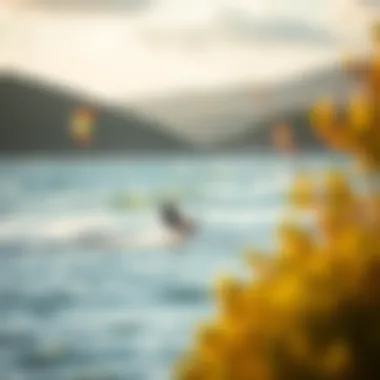
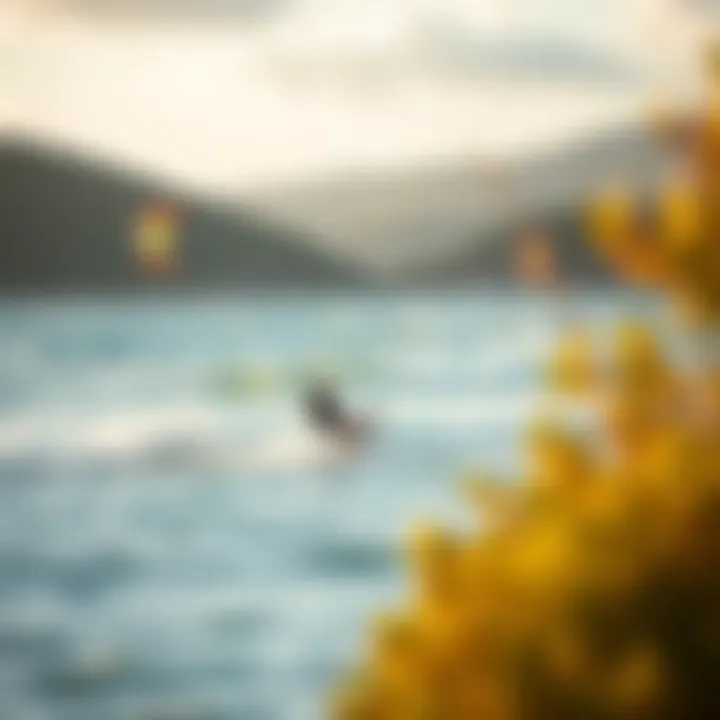
- Understanding Tides: The rise and fall of tides can change the landscape of your kitesurfing spot. In shallow areas, especially, low tides can expose obstacles such as rocks and sandbars, making navigation tricky. However, high tides can provide a perfect playground, yielding additional space to ride freely.
- Currents: Currents can either be a kitesurfer’s ally or enemy. A favorable current can help propel you forward, enhancing your speed and overall experience. Yet, a strong current against you can feel like paddling uphill on a bicycle. Knowing the current patterns of your chosen kitesurfing location is essential.
- Safety First: It’s imperative to check tide charts and current information before heading out. Even the best-laid plans can go awry in the face of unexpected tidal changes. A sudden shift can lead to disorientation, putting a damper on what could have been an amazing day on the water.
"In kitesurfing, it’s not just about the kite; it’s about reading the wind and water like an open book. Those who do, truly ride the waves."
For more information on the impacts of weather on kitesurfing, you may check out resources like National Oceanic and Atmospheric Administration and Wikipedia.
Kitesurfing Culture and Community
Kitesurfing isn't just about flying a kite and riding the waves; it’s a lifestyle, deeply embedded in a vibrant community that spans across the globe. This culture champions not only the thrill of the sport, but also the friendships, shared experiences, and the collective passion that brings people together. In this section, we explore the pivotal role that community plays in kitesurfing, the way experiences and knowledge are shared, and how competitions and events shape the fabric of the kitesurfing world.
Sharing Experiences and Knowledge
The act of kitesurfing itself can be exhilarating, but the stories that come with it create a rich tapestry of shared experiences.
Why is sharing experiences important?
- Growth and Learning: New and experienced kitesurfers often exchange tips and tricks, helping others improve faster.
- Safety Awareness: With shared tales of mishaps and near misses, members of the community collectively enhance their understanding of safety measures and best practices.
- Building Bonds: The camaraderie developed through shared experiences can lead to lifelong friendships. A common passion for kitesurfing often turns into a support network for enthusiasts and professionals alike.
Local groups and online forums might have members sharing their video logs or writing about their first rides on particular Ozone kites. These stories can be the lifeline for someone gearing up for their first session, perhaps recounting the jitters and how to manage them. As those who have braved tough winds will tell you, knowing you’re not alone can make the world of difference. You can catch a glimpse of community interactions over at platforms like Reddit.
Competitions and Events
Competitions and events are crucial for any sport, and kitesurfing is no exception. They elevate the level of the sport while also drawing attention to local kiting locations, fostering tourism and community support. Here’s how they contribute:
- Skill Showcasing: Competitions offer a platform for riders to showcase their skills. This not only encourages personal growth but sets a benchmark for aspiring kitesurfers.
- Community Togetherness: Events typically bring people from all walks of life together. From novice kitesurfers watching the pros to longtime friends sharing a beach, the atmosphere buzzes with energy and encouragement.
- Promoting Talent: Platforms like the “Ozone Kitesurfing World Championship” highlight exceptional talents, paving the way for potential sponsorships and professional careers.
Each kitesurfing event presents the opportunity to gather with like-minded folks and speaks volumes about the community spirit. Such occasions often host workshops—whether it’s about mastering a trick or understanding the mechanics behind kite performance. They serve as interactive classrooms where knowledge is passed down seamlessly.
"The beauty of kitesurfing isn't just in the adrenaline rush, but in the bonds we forge through the shared passion for the sea and wind." - Anonymous
Communities can be found in various formats—local clubs, online groups, and even at events throughout the year, encouraging a more connected world for kitesurfers of all levels.
Environment and Conservation in Kitesurfing
Kitesurfing isn’t just about the thrill of riding the wind and waves; it’s intricately linked to the health of our planet. Environmental and conservation aspects are crucial to ensuring that future generations can enjoy the beauty and excitement of kitesurfing as much as we do today. This section delves into the various facets involved in maintaining this delicate balance between adventure and our duty to safeguard marine environments.
Sustainable Practices
Sustainable practices are not just buzzwords; they are essential actions that kitesurfers can adopt to minimize their impact on the natural world. Here are a few key practices that can make a difference:
- Using Eco-Friendly Gear: More brands, including Ozone, are now producing gear that is crafted with environmentally conscious materials. This includes biodegradable or recycled options that lessen our carbon footprint.
- Respecting Natural Habitats: Kitesurfers should be mindful of local ecosystems. This means avoiding sensitive areas like nesting grounds during critical periods, keeping a safe distance from marine wildlife, and being cautious about where you rig and launch your kite.
- Participating in Clean-Up Efforts: Engaging in beach clean-up days not only helps preserve the beauty of our kitesurfing spots but also fosters community spirit among kitesurfers. Getting involved in local environmental initiatives can be incredibly rewarding.
These practices, although small on their own, collectively contribute to a healthier marine environment and can greatly enhance the kitesurfing experience.
Impact on Marine Ecosystems
The impact kitesurfing can have on marine ecosystems is a double-edged sword. On one hand, the sport brings more attention to coastal areas, which can lead to conservation efforts. On the flip side, without proper consideration, kitesurfing can disrupt delicate marine habitats. Some critical points to note include:
- Wave and Wind Conditions: Kitesurfers should be aware that their activity can contribute to the disturbance of marine life, particularly in shallow waters where many species thrive. Understanding local regulations about where to ride is crucial to protect these ecosystems.
- Contribution to Climate Awareness: The actual practice of kitesurfing—experiencing the ocean and its wonders—often leads individuals to become advocates for marine conservation. Once you understand the impact of climate change on ocean conditions, it spurs a desire to become part of the solution.
- Ecosystem Awareness: The awareness gained through kitesurfing can extend beyond the water. As surfers interact with their environment, they become more knowledgeable about crucial issues such as pollution and coastal erosion. This knowledge can translate into greater advocacy for broader ecological initiatives.
"Kitesurfing doesn’t just connect us to the wind and waves; it connects us to the urgency of protecting these environments for our enjoyment and the well-being of our planet."
By fostering a culture of conservation within the kitesurfing community, we can ensure that our beloved sport coexists harmoniously with the marine ecosystems we cherish. The responsibility lies in our hands to balance exhilarating kite runs with a commitment to sustainability, making sure that we leave nature as we found it, or better.
For additional resources on environmental conservation in water sports, visit National Oceanic and Atmospheric Administration and Marine Conservation Society.
Epilogue
In wrapping up the discussion on Ozone kitesurfing, it's paramount to highlight the significance of understanding both the gear and the sport itself. The world of kitesurfing is not merely about riding the waves; it is an intricate dance with nature, where gear plays a crucial role in both performance and safety.
Recap of Key Insights
Through our exploration of Ozone kites, we’ve discovered a myriad of insights that cater to kitesurfing enthusiasts, both new and seasoned. Here are some key takeaways:
- Innovative Features: Ozone has consistently pushed the envelope with their kite designs, integrating sophisticated technology that enhances user experience. Their commitment to research ensures riders enjoy not just better performance but also increased safety.
- Diverse Range of Kites: Understanding the different types of kites—freeride, wave, foil, and hybrid—enables riders to select the appropriate equipment based on their preferences and skills.
- Safety Practices: Emphasizing the importance of comprehensive safety measures, from pre-flight checks to understanding and utilizing safety systems, can significantly reduce risks on the water.
- Environmental Awareness: The integration of conservation practices into kitesurfing culture stresses the community’s responsibility towards marine ecosystems, which should resonate with all riders.
The Future of Ozone Kitesurfing
Looking ahead, the future of Ozone kitesurfing appears robust and promising. The brand's ongoing commitment to innovation suggests that we might witness even more advanced materials and designs that could elevate kitesurfing to unprecedented heights.
- Technological Advancements: With the rise of responsive and adaptable kite materials, we may see kites that adjust automatically to changing wind conditions. This could lead to safer practices, especially for beginners.
- Increased Inclusivity: Ozone's focus on making kitesurfing accessible continues to grow, with programs aimed at teaching diverse communities how to kite. By promoting inclusivity, the sport can attract a wider base of participants, ensuring its sustainability and growth.
- Collaborative Conservation Efforts: The future also lies in stronger partnerships between kitesurfing organizations and environmental groups. Joint ventures can pave the way for more initiatives that protect watersports' natural habitats while educating the community on eco-friendly practices.
"The best way to predict the future is to create it."
For more in-depth information on kitesurfing, you can visit Wikipedia or check out the latest discussions on Reddit.
Educators and conservationists can explore valuable resources through academic and government sites, ensuring a well-rounded understanding of the sport and its impact.



